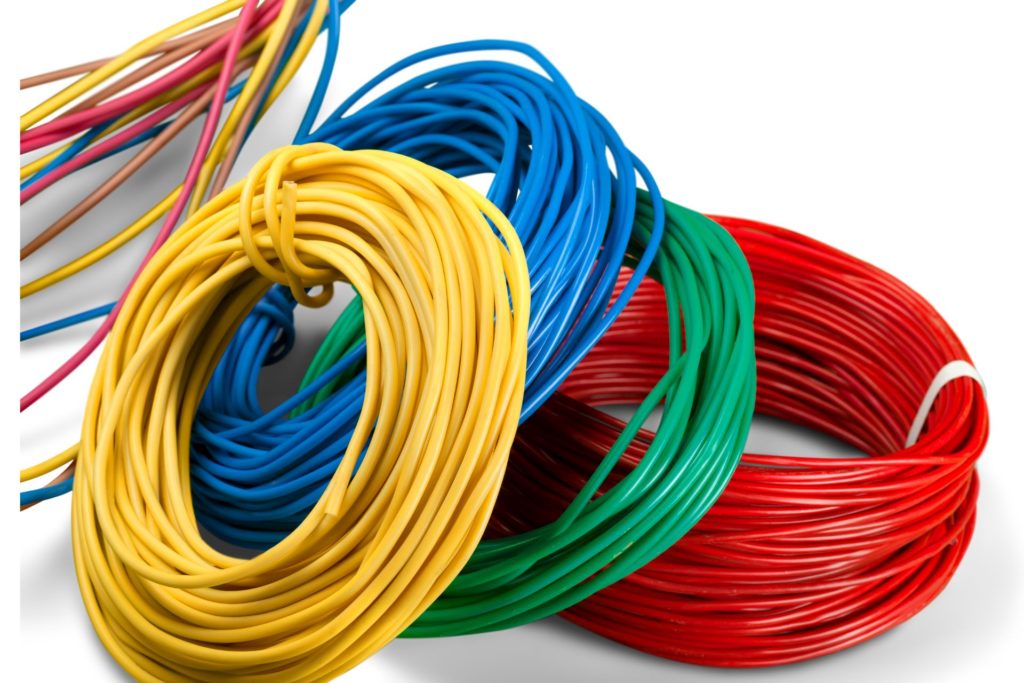Are you thinking about buying 2-gauge wire? The first question you have to ask is whether this gauge is suitable for your applications. But you can’t answer that question without determining the ampacity of this wire size.
How Many Amps can 2 Gauge Wire Handle?
2AWG copper wire can handle 95A at 60 degrees C, 115A at 75 degrees C, and 130A at 90 degrees C. If you have aluminum (or copper-clad aluminum), it can carry 75A at 60 degrees C, 90A at 75 degrees C, and 100A at 90 degrees C.
2 Gauge Wire Amps Rating
| Copper | Aluminum | |||||
| Wire Gauge Size | 60˚C NM-B, UF-B | 75˚C THW, THWN, SE, USE, XHHW | 90˚C THWN-2, THHN, XHHW-2, USE-2 | 60˚C TW, UF | 75˚C THW, THWN, SE, USE, XHHW | 90˚C XHHW-2, THHN, THWN-2 |
| 2AWG | 95 | 115 | 130 | 75 | 90 | 100 |
If your region doesn’t use the AWG measurement, 2-gauge wires are 0.2576 inches in diameter. If you prefer mm, the diameter is approximately 6.544 mm or 33.6 mm2 (cross-section).
Read 4 Gauge Wire Amp Rating With Respect To Distance, Watt, Volt
Things To Consider Before Using 2AWG

1). Some people have never even heard of AWG. That sounds ridiculous, but it is true. Many regions prefer units of measurement like inches, mm, and mm2. Although, it isn’t difficult to understand why AWG is so popular.
AWG is a unit that reveals a cable’s thickness. It stands for ‘American Wire Gauge.’ The AWG looks at the thickness of the conductor alone. It doesn’t include the sheath. The AWG is very easy to interpret.
2). The AWG is represented by numerical figures. AWG is fascinating because it associates the thickest cables with the smallest numbers. For instance, 2AWG is thicker than 4AWG.
3). Because the smallest numbers refer to the thickest cables, this unit of measurement is basically counting down. Some people naturally assume that 0 is the smallest number in this situation, but that isn’t true.
This system has sizes below zero, such as 2/0 and 3/0. Many laypeople select the wrong wire because they confuse 2/0 with 2AWG. In fact, they keep using the two figures interchangeably without realizing that 2/0 is actually thicker.
You can transmit 200 amps of electricity with 2/0. On the other hand, the average 2AWG cable is restricted to 130 amps, depending on the material and temperature rating.
4). The thickness matters because it reveals the amount of electricity a wire can carry. In turn, this shows you the loads the conductors can accommodate, not to mention the resistance and voltage drop you will encounter.
If you visit a local store to buy electrical wire, the retailer will start by asking you to specify the size of the cable you need. If you don’t know the size you need, they will expect you to reveal the amps your application requires.
The amps of the task will show them the appropriate AWG for your situation.
5). Applying the wire size to the breaker size is not quite as straightforward as many people think. They tend to match the ampacity of the wire size to the ampacity of the breaker.
For instance, they think a 100A breaker requires 3AWG because 3AWG can transmit 100 amps. But that is not true.
I want you to remember that you can only use 80 percent of a circuit’s ampacity.
Therefore, if you have a 100A circuit, you should only use 80 amps. What does this mean? You need a wire size whose ampacity exceeds 100 amps to account for the 80 percent rule.
6). Now that you know what the AWG is, how it works and how you can apply the unit, you may start to wonder how contractors calculate the ampacity of the wire size.
If you’ve seen the equations that calculate the voltage drop, you’re probably scratching your head because you don’t understand what they mean, let alone how you can apply them.
But those equations shouldn’t scare you. Ultimately, they don’t matter to you. Engineers may occasionally use them to calculate wire size, ampacity, resistance, and voltage.
But you can ignore them. Once you know the wire size, you can use it to find the amps by looking at the NEC’s tables. Look for ‘2AWG’ in the wire size column. Once you locate it, look at the corresponding rows to identify the ampacity.
Does Distance Affect 2-Gauge Wire Amp Rating?
Considering 95A, you can run 2 AWG copper wires for a maximum of 112 feet in a 120V circuit, 224 feet in a 240V circuit, and 449 feet in 480V. This is for a single phase. In a three-phase system, you can run 129 feet in a 120v circuit, 259 feet in a 240v, and 518 feet in a 480v with a voltage drop of 3 percent. So, yes distance affects wire amp rating.
For Copper Wire,
Single Phase
| Voltage | Amp | Voltage Drop | Max Distance |
| 120 | 95 | 3% | 112 ft |
| 240 | 95 | 3% | 224 ft |
| 480 | 95 | 3% | 449 ft |
Three Phase
| Voltage | Amp | Voltage Drop | Distance |
| 120 | 95 | 3% | 129 ft |
| 240 | 95 | 3% | 259 ft |
| 480 | 95 | 3% | 518 ft |
The distance increases the resistance, and the resistance elevates the voltage drop.
Some appliances may stop working because the voltage drop has prevented the conductors from transmitting the necessary current. Therefore, if you want to increase the distance, you should also raise the gauge.
A higher gauge guarantees a greater amperage. However, if you already have a 2-gauge wire, the distance won’t affect its amp rating. Instead, it will determine whether or not the 2AWG wire is suitable for your application.
In other words, if the distance is too great, and you are worried that a 2-gauge wire’s voltage drop will exceed 3 percent because of the extended length, you should skip to the next gauge.
Read 10 Gauge Wire Amps Rating
Does Voltage Affect 2-Gauge Wire Amps?
No, the voltage doesn’t matter. The goal of identifying the gauge is to figure out the amount of electricity the conductors can safely transmit. The voltage doesn’t factor into that equation.
| Voltage | Amps |
| 12 V | 95-130A |
| 24 V | 95-130A |
| 120 V | 95-130A |
| 240 V | 95-130A |
You can consider the voltage if you want to explore different types of insulation and their thickness. Otherwise, you don’t need the voltage to find the wire gauge or ampacity.
Does Material (Copper/Aluminum) Affect 2AWG Amp Rating?
The material affects the amp rating of 2-gauge wiring. Have you noticed that your contractor seems to prefer copper to aluminum? There’s an important reason why.
Copper is highly conductive. The metal has very few rivals in this arena. In fact, silver is the only other material more conductive than copper.
As you may have guessed, that conductivity gives copper wires superior amp ratings to their aluminum counterparts. A smaller copper conductor will transmit more electricity than a larger aluminum cable.
This is why electricians replace 4AWG copper lines with 2AWG aluminum wires. They know that 4-gauge aluminum lines cannot transmit the same volume of electricity as 4-gauge copper cables.
But that is not the only factor that sets copper apart. It is also more heat resistant, permitting less expansion and contraction. Additionally, it can resist corrosion.
The high conductivity allows contractors to use thinner wire strands that offer greater malleability. You can’t deny the fact that copper is the clear winner. Although, many homeowners will gladly use aluminum instead of copper because it is the cheaper option.
You can afford to deploy copper in smaller, simpler projects. But a massive undertaking that requires miles of wire may bankrupt you if you choose copper.
For that reason, many contractors gravitate towards aluminum because they know it can replicate some of the attributes of copper if they secure the conductors in a higher gauge. Remember that aluminum is lighter and, thus, much easier to install.
What Does The NEC Say About It?
According to NEC, 2-gauge wire’s rating ranges from 75 to 130 amps.
Many people don’t know what to do about 2AWG cables because the estimates some tables have provided tend to vary.
Therefore, homeowners don’t know which amp rating to apply to their calculations. However, if you have any doubts about the information you have seen in the online tables, you should ignore all those tables in favor of the NEC’s tables.
The NEC won’t lead you astray. Many regions base their electric codes on the NEC’s regulations. In other words, you can ignore tables whose estimates differ from the NEC’s information.
Usage Of 2-Gauge Wire
The reason why you’ve never seen 2AWG wires is that they are incredibly thick. Many of the standard applications in your home don’t require cables this thick.
2-gauge wire works in service panels and sub-panels. It can run applications with very heavy electrical requirements. That includes welding.
But that is not an excuse to apply 2AWG to every device you have in your home. Yes, 2AWG conductors can transmit massive volumes of power without overheating.
You can run your freezers and washers without worrying about fires. However, 2AWG cables are also expensive because these are some of the thickest conductors you will find in your local store.
Also, the thickness makes them very stiff. Can you imagine how challenging it would be to pull 2AWG wires through a conduit? They are not worth the hassle if you don’t need them.
2 Gauge Wire Watt Rating
Considering 95A, 12V gives 1140W, 120V gives 11400W, 240V gives 22800W and 480V provides 45600W.
| Amp | Voltage | Watt |
| 95A | 12V | 1140W |
| 95A | 120V | 11400W |
| 95A | 240V | 22800W |
| 95A | 480V | 45600W |
You get the watts by multiplying the amperage by the voltage. Therefore, increasing the amperage will also increase the wattage.
Related Post:

